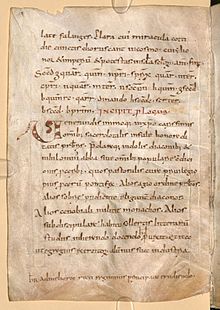


Hygeburg (floruit 760–780), also Hugeburc, Hugeberc, HunebercorHuneburc, was an Anglo-Saxon nun and hagiographer at the Alemannian monastery of Heidenheim. She is "the first known Englishwoman to have written a full-length literary work"[1] and "the only woman author of a saint's life from the Carolingian period".[2]
Heidenheim was founded as a monastery for monks in 752 by Wynnebald, an Anglo-Saxon from Wessex.[1] On his death in 761, his sister Walburg inherited it and converted it into a double monastery with the introduction of nuns.[1] Hygeburg was among those who came to Heidenheim immediately after Wynnebald's death.[1] Probably she had already been in Germany for some time, one of the nuns summoned by Boniface.[1]
Hygeburg was, in her own words, "a humble relative" of Wynnebald, Walburg and their brother, Willibald.[1] On Tuesday, 23 June 778, while he was visiting Heidenheim, Willibald dictated to Hygeburg an account of his pilgrimage to the Holy Land in the 720s[2] or 730s.[1] She subsequently worked this account into a biography of Willibald,[1] called the Hodoeporicon ("relation of a voyage").[2] (The conventional name Vita Willibaldi, "Life of Willibald", was given to it by editors.[3]) From her choice of phrase and motif, she must have had access to the Carmen paschale, the Vita Bonifatii and the riddles of Aldhelm.[1]
Although there was opposition to her writing within the convent, Walburg encouraged it. Hygeburg also wrote a biography of Wynnebald, the Vita Wynnebaldi.[1] Although her two works were a single project, completed by 780, they are textually distinct, indicating her use of oral reports and eyewitness testimony.[1] She was herself a witness to some of the post-mortem miracles she attributes to Wynnebald's intervention.[1]
The name of the nun who wrote the lives of Willibald and Wynnebald was not known until in 1931 Bernhard Bischoff discovered it in a cryptogram in the oldest manuscript (from c. 800).[1]
|
| |
|---|---|
| Cartography |
|
| Late Roman and Byzantine period |
|
| Early Islamic period |
|
| Crusader period |
|
| Later Islamic period |
|
Many of these texts have been translated and published by the Palestine Pilgrims' Text Society. | |
| International |
|
|---|---|
| National |
|
| People |
|
| Other |
|